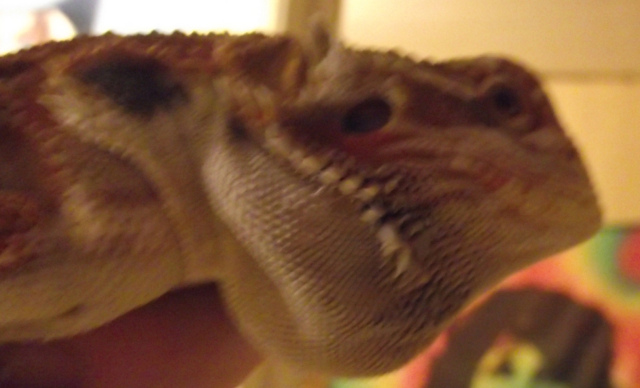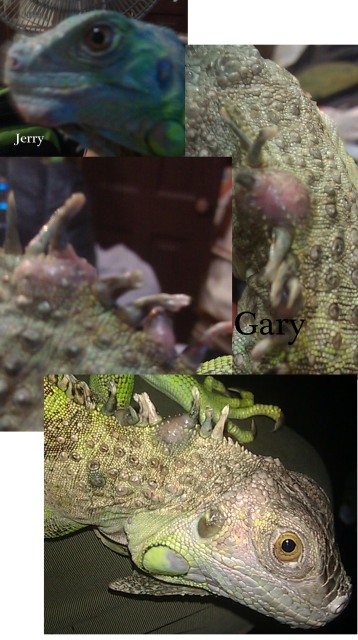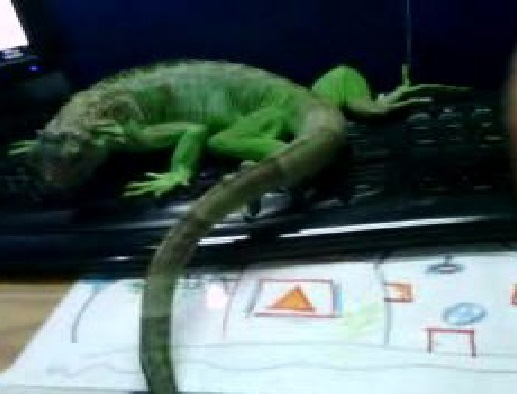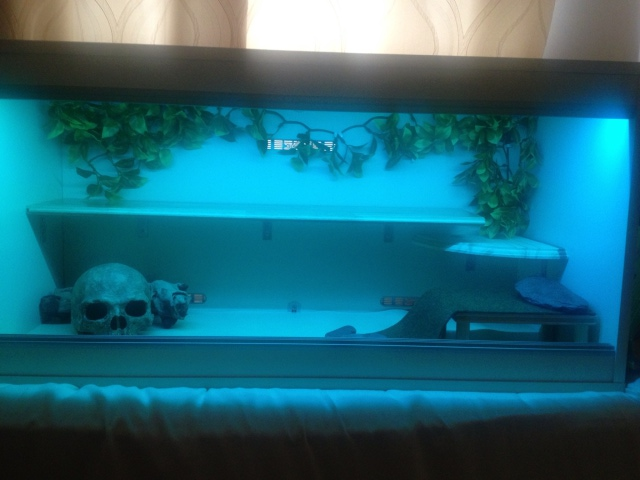QuestionQUESTION: Hi Diane,
I'm about to get myself a leo of my very own and i'd like to know a bit about the lighting arrangments. I've probably looked at about 10 sites by now and a good half of their experts are all for under tank heating while the other swears by the uvb (white day light) and red light for night time. Any advice on which works best?
Also, with reference to the moist hide box, does it need to be on the warm side of the cage or the cool side? Lastly the pet store i'll be purchasing from offers both gut-loaded meal worms and crickets, calcium powder dusting aside, is one better than the other in terms of nutrition and overall Gecko health?
Thanks for your time :)
ANSWER: Jo Jessie,
Great questions!!!
My thoughts on uvb lighting are this... unless something lives in the deep dark bowels of a cave, they are, at some point getting uvb. I give my leos uvb and always have. I use either the 2% uvb tubes or use my older uvb tubes for daytime light.
For heat, both day and night, I use a ceramic heat emitter for overhead heat and an undertank heater on 1/3 of the tank. I have no light at night. Many people do use the moonlight bulbs for nighttime but to me, they do not last long and are rather expensive. What it comes down to is this... what your leo is comfortable with...and what you have available where you are located. ALWAYS provide bottom (floor) heat to 1/3 of the tank where a hide is. Leos are ground dwellers so they depend on the warm ground to regulate their temperatures. If you want, you can use only the floor heat at night but I've found it easier to just have both on a thermostat. I have my daytime light on a timer.
As to gut loaded... ALL insects MUST be gut loaded for at least 24-48 hours prior to feeding them to your leo. If the insects aren't fed a nutritious diet, the leo does not get proper nutrition. Again, insects MUST be gut loaded.. I know that the pet store charge more for gut loaded, but..not sure what they are using to feed the crickets. Save the money, get the regular crickets and gut load them yourself..this way you know they are getting the proper nutrition they need to give your leo proper nutrition. I'm including a basic care sheet that I wrote to help people out. More on gut loading is in the care info.
My two heat sources are on 24 hours a day. My leos have their choice of cool hides or warm hides. My humid hides are on the warm side of the tanks.
BASIC CARE FOR A LEOPARD GECKO
Leopards are pretty easy to care for but they do need
special care. Here are some of the basic needs of your gecko.
HOUSING: The need to have at least a 20 gallon long tank for one Leo. This needs to have a secure fitting screen top...they can be quite the escape artists!!! They need to have a humid hide box.You can make this with something as simple as a small plastic dish with a hole cut in one side and a small mesh bag filled with some Sphagnum moss coconut bark or Peat moss that you mist.
I made mine out of the small plastic folgers coffee containers...I cut an opening in the lid..and put the moss in..they LOVE it. I use the terrarium moss in mine.
I use that on the warm side of the tank. Be sure to provide a cool hidebox on the other end. I also provide a mid temperature hide...which is in the middle of the tank.I use the critter caves which you can purchase. NOT the ones that have heat in them!!!!
Provide secure climbing areas for your gecko. Fake plants, rocks and branches are all fine to use. be sure there are no wires or sharp ends to any fake plants you use.
*****SUBSTRATE:(that's the stuff on the floor of your tank) Newspaper, lizard carpet or paper towels work great and are easy to clean and are much safer than any loose substrate. Sand or other loose substrate is not recommended as that they can be deadly to the leo when it is ingested(eaten, even by accident while eating their insects)...A very graphic site of an impacted leo surg can be seen at http://homepage.mac.com/exoticdvm/reptile/PhotoAlbum181.html it is very graphic!!! ******What I have found that works great for safety and heat distribution is using about 1/4 inch of childrens play sand(since the tiles fit tight together, there is no sand danger) on the bottom of the tank and on top that you place ceramic or slate floor tile. What is nice is that the 12 x 12 squares fit perfect in a 20 gallon tank with no spaces between the tiles. The sand and the tile distribute the heat wonderfully. Using the under tank heater as described is what distributes the heat. Also, overhead heat will help in heating the tiles...I've been using this set up for several years and the leos love it. Using a tile that isn't smooth is recommended. **********
TEMPERATURES: They need a warm area ( on the floor) of 88-92 degrees and a
cooler area in the upper 70s, low 80s. At night their temperature can drop to the low to mid 70's.
Never use a hot rock for a leopard gecko...or any reptile.
They can severely burn any reptile. You can use a heating
pad under the tank,under tank heater for the warm area. You can use a regular household lightbulb in a dome fixture with a ceramic socket in it to keep the warm area at the 88-92 degree area if needed there, otherwise, placing the lightbulb about midway in the tank will give the needed temeratures throughout the tank. You may have to play with the wattage of the bulb but generally 40-60 watts is sufficient.At night, no white light. If room temperatures stay above 70 degrees, no extra night heat is needed. The undertank heater or heating pad should cover about 1/3 of the tank....be sure to raise the tank up about 1/4-1/2 inch off the stand when using an undertank heat source to prevent heat build up which can cause the glass to break and hot spots in the glass. Be sure to have a good layer of newspaper, carpeting or, even a thin flat rock(such as tile) on top the area that the undertank heat source is placed...if you use a thin rock or tile, it helps to distribute the heat very well.
You can use the special nighttime lights that are designed for reptiles. I like using a ceramic heat emitter on a thermostat for nighttime heat.
DO NOT use black lights or party lights as they can cause eye damage!!!!
The wattage you use will vary based on room temperature and size of tank.
LIGHTING: Leopard geckos do not need UVB lighting but it does not hurt them to give them uvb. They should have some type of light during the day, be it a uvb tube, regular florescent light, reptile day light or regular household lightbulb. NO white lights at night!!!
FEEDING: Geckos should not be fed crickets or other insects that are bigger than the space between their eyes. Generally, hatchlings can be fed more than once a day,juvys can be fed twice a day, adults are fed once daily or every other day, in the early evening. Crickets and other food items such as silk worms, super, and an occasional treat of a wax worm, need to be dusted with a calcium supplement two times a week and also they should have a small dish of calcium in their tank. I use the lid of a milk jug for the little dish of calcium in their tank. For dusting the insects, Use a calcium with no added phosphorus. Insects must be gut loaded(fed) for at least 48 hours prior to feeding your gecko. Remove any uneaten crix or superworms after 15-20 minutes..... Place a piece of cut potato in the tank so that if you have missed any uneaten insects, they will eat the potato instead of nibbling on your gecko!!!
*************You have to be sure to feed your crickets and insects the right foods before feeding them to your gecko. If your crickets/insects are not healthy and well fed, your gecko will not get the nutrition he needs. You can gut load your crickets and insects greens, veggies, cereals or specially designed commercial foods for crickets or the insects you are feeding. ************
Be sure to have a small dish of clean water for your gecko at all times!!
You can offer them some baby food or fruits on occasion ...
Mine will even eat a small piece of watermelon now and then.WATER: always provide a dish of drinking water. If you choose to mist your gecko to drink, its best to not get the tank too wet as that they do not do well with higher humidity. Sometimes its better to take your leo out of their tank to mist them to get them to drink!!!
HANDLING: Some geckos enjoy being held...others prefer not to be handled at all. Be sure to be very gentle when holding your leo and NEVER grab them by the tail! Their tails are extremely fragile and will break.
I do suggest finding a vet that can treat reptiles BEFORE you actually need one!!! To find a vet that is able to care for reptiles:
http://www.herpvetconnection.com
http://www.arav.org/ECOMARAV/timssnet/amm/tnt_mdsearch.cfm
http://www.anapsid.org/vets/
For more information on leopard geckos:
http://www.drgecko.com
If you have any questions or don't understand something, please let me know.
---------- FOLLOW-UP ----------
QUESTION: Hi Diane,
Thanks you for the fast reply and good advice. I would also just quickly like to ask about the age at which a leo can be considered an adult. Ive been told they reach sexual maturity within 18 months but in terms of your feeding chart (Hatchling-juvenile-adult)what size/age will it be before I can start the once a day/every other day feeds?
I also wanted to ask about any common illnesses or problems in leo's that I should be aware of. Obviously if the leo stops eating or gets thin or lethargic I'll know somethings up, but are there any more obscure problems or symptoms that I can try to look out for, thus avoiding the possibility of catching an ailment too late?
Lastly,how often would you advise a check up with the vet?
Thanks again for all your help and time :)
AnswerHi Jessie,
Many consider adulthood when they reach sexual maturity..but MOST, if not all ethical, well informed people go with the 18 month age for maturity AND breeding age. Sad thing is, many people will allow them to breed before a year of age.. not recommended at all.
Your leo will most likely tell you when you can change feeding schedule. You may see a difference in how much he.she wants to eat at about 9-12 months. You can stay with the daily feedings forever if you want..or you can try every other day at 9-12 months but if your leo is acting hungry or loosing weight then of course you will have to go back to daily. By the same token, if your leo is getting too heavy, you may have to change the amount of insects or feeding schedule. Leos will develop fat pockets in their chest/arm pit area when they are too heavy.
There really aren't any common diseases that leos can get. A few things that can happen of course the the reptile mites, respiratory infections, stuck shed, eye injuries, ear injury, scrapes, etc. I did loose one to a ruptured gallbladder but that isn't common nor is there any sign that it will happen.
Internal blockages can occur. Internal parasites of course can happen.
Loosing weight is one of the biggest concerns. Being lethargic is another. Of course drainage from eyes, ears, nose, mouth, etc are also signs of something going on. Retained shed can cause tail tips and toes to develop dry gangrene, infection and the digit or tail tip falling off. Always check toes, etc after shedding to be sure all shed is removed. If stuck shed is noted, applying some Vaseline to the area can loosen it..also a warm soak in shallow water can help. Having something that is semi rough in the cage for them to rub against can help with stuck shed. Bark is a good source of a rough item.
Watch for torn claws if using lizard carpet.
Never use sand of any type in the leos tank.
Internal blockages...leo will not eat generally, will strain to go to the bathroom w/o producing anything, stomach can look distended/bloated
Prolapse... straining to go to the bathroom can cause a prolapse of the rectum or other internal organs as can dehydration. If this happens, soaking the leo in a solution of sugar and warm water(1/2 cup water to 1/2 cup sugar) can help to shrink the tissue to go back into place and also will keep the area moist while on the way to the vet.
As to vet check ups... of course anytime you aren't sure you need a vet, you need a vet!! Yearly check ups for internal parasites is recommended.
Hopefully I've covered all your questions..if not, please let me know. You have great questions!

 Bearded Dragon Neck
QuestionQUESTION: My bearded dragon is 8 months old. Sh
Bearded Dragon Neck
QuestionQUESTION: My bearded dragon is 8 months old. Sh
 i believe that my leopard gecko may be dying.
QuestionQUESTION: At first, she stopped eating. I notic
i believe that my leopard gecko may be dying.
QuestionQUESTION: At first, she stopped eating. I notic
 Iguanas abscess
Questionabscess
QUESTION: I have two 4 year old
Iguanas abscess
Questionabscess
QUESTION: I have two 4 year old
 Iguana acting weird with tail
QuestionQUESTION: Hello there.. For the last 10 minutes
Iguana acting weird with tail
QuestionQUESTION: Hello there.. For the last 10 minutes
 leeloo leo gecko
Questionviv
viv
QUESTION: Hi Tracie,
Yo
leeloo leo gecko
Questionviv
viv
QUESTION: Hi Tracie,
Yo